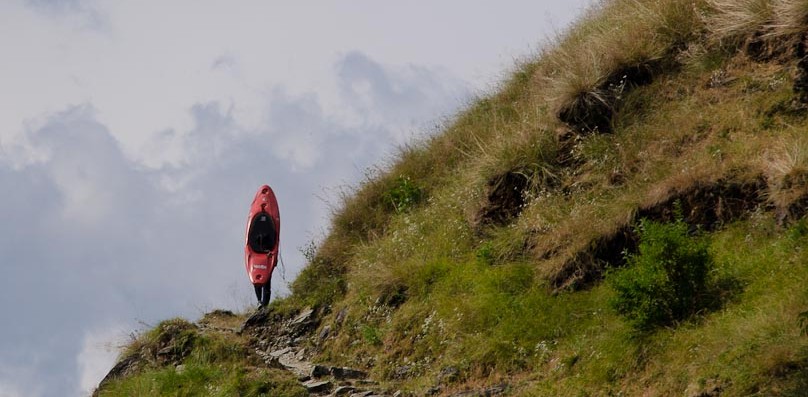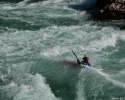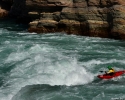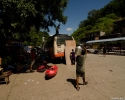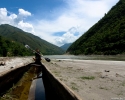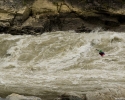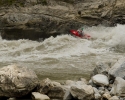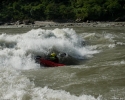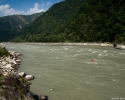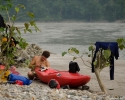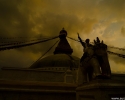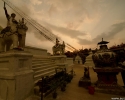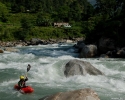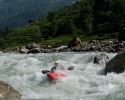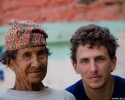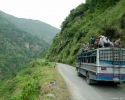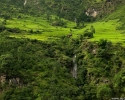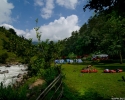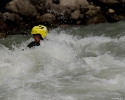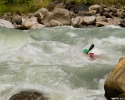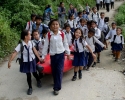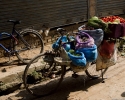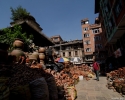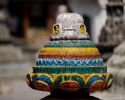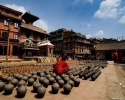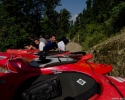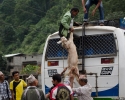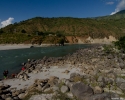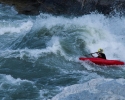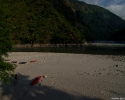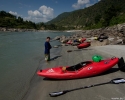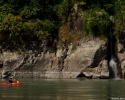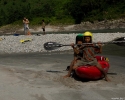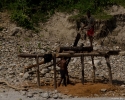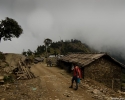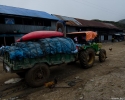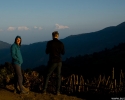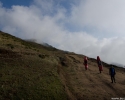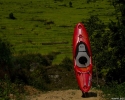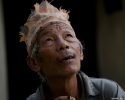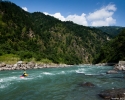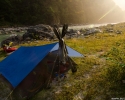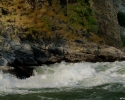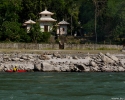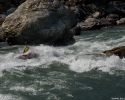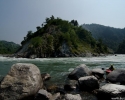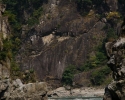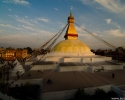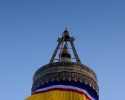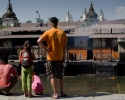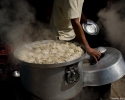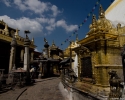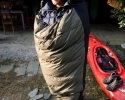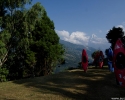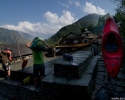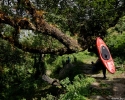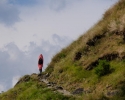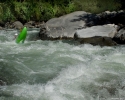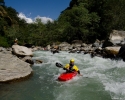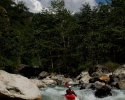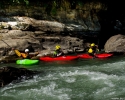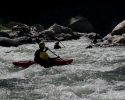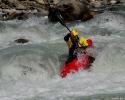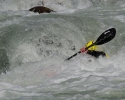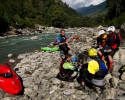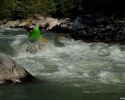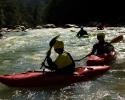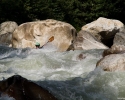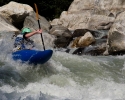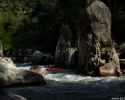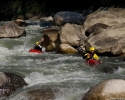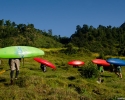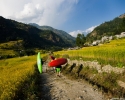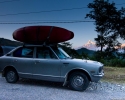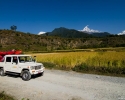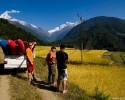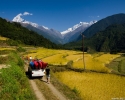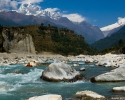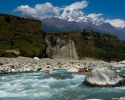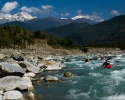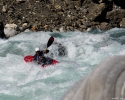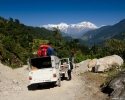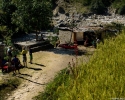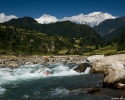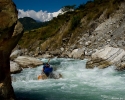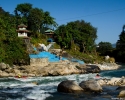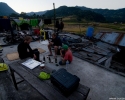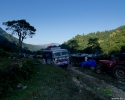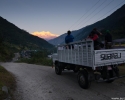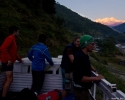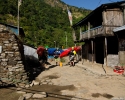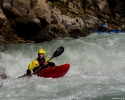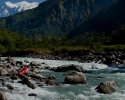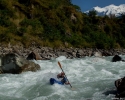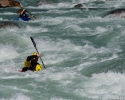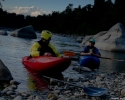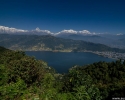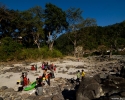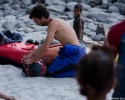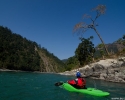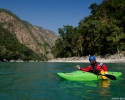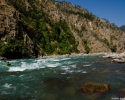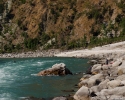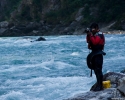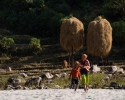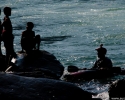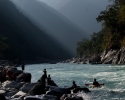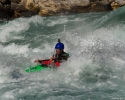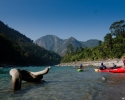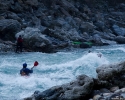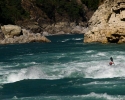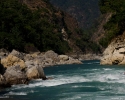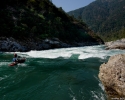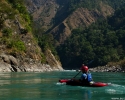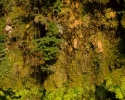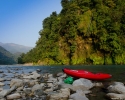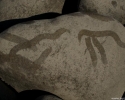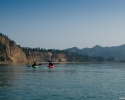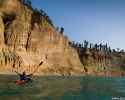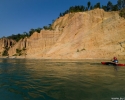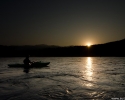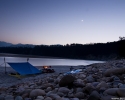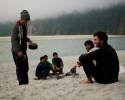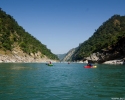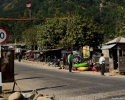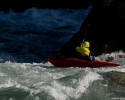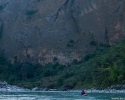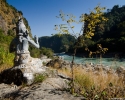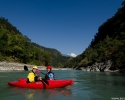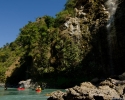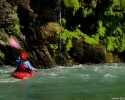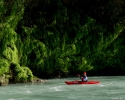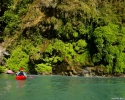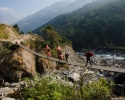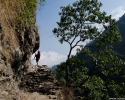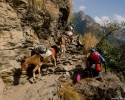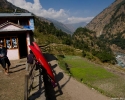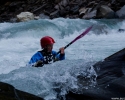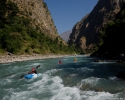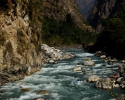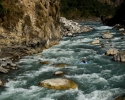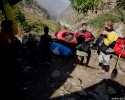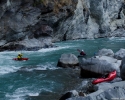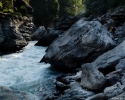Nepal – Kayaking in the shade of the Himalayagiants
I am sitting in the departure hall of Kathmandu – Nepal International Airport with a firm will. On the one side I had experienced more than I had ever dreamt of over the last two and a half month. I had gotten very close to the highest mountains in the world and on one of the most beautiful ones, the 6856m high Ama Dablam, I summited after an acclimatisation tour on an other 6000m peak. On the other side I´m a paddler with all my heart and as we crossed rivers with well known names like: Dudh Kosi or Sun Kosi I had known I will return to this great country, but then with my kayak. That was in the year 2004.
It took me eight long years until I found the possibility to return.
Rain clouds and a choppy wind over Kathmandu shook the plane hard as we started our descent. A short glance in the faces of the fellow passengers told me that they were glad as the plane arrived its parking position safely. The following thought brought a smile upon my face. I had a bit less than three months time to explore and paddle, together with friends, the rivers of the Himalayan country.
That the clocks here tick differently a bunch of nagging Germans had to experience at the immigration counter. They were just ignored, therefore I got my visa fast and was soon able to collect my kayak. A last scrutinizing look of a policeman if the baggage-number on my kayak matches the one on my tag and a second later I was surrounded by taxi drivers who all offered me the “cheapest” fare to Thamel. Fortunately, Georg, who had arrived some days earlier, picked me up and so I was able to avoid being ripped of. The taxi driver couldn’t believe that we didn´t want t go to Thamel, the main tourist quarter, but to Bouddha. As Georg asked him to stop at a random corner the very talkative driver was left speechless. I wasn´t sure if George knew where we were either because of his puzzled face. But he led the way, zigzagging through narrow, muddy roads and soon stood in front of a green gate. Georg opened the gate confident and stepped in. We found ourselves in a very beautiful garden with a very English looking lawn, some flowers and well-cultivated hedges. The flat on the third floor belonged to some of Georg´s distant relatives and we could use this place of tranquillity and peace in the middle of hectic Kathmandu as basecamp. The family of Gwen and Ishwor with their three kids Tara, Maja and Aduaja gave us a warm welcome.
Ouch!!! – I had burnt my finger. As usually in Nepal we ate with our fingers and I had forgotten that freshly cooked meals are sometimes hot. Tara and Maja appreciated it with a smile and a blister reminded me for long.
The next days Georg and I were busy sightseeing, sometimes the two daughters were our guides and with the preparations for our first river. Slowly we noticed the end of the monsoon hence the rain got less and so on a beautiful day we started heading east for the famous Sun Kosi.
Our fully loaded kayaks weighed 37kg when we carried them over the bridge in Dolalghat, our put-in. Finally, it was a great feeling to be on a river in Nepal after eight years. On the first afternoon we passed pretty, tiny villages, scenic gorges and had one or another rapid. One of them caught me off guard with my back belt open and forced me to my first roll in Nepal. At 5pm we started looking for a campsite and soon found a good spot on river right. Quickly the routine from Madagascar kicked in and soon we had a descent meal simmering in our pot. We couldn´t believe it, when looking at the map it showed that we covered 50km in less than four hours. A shower at night caused some hectic because we had been too lazy to pitch the tarp.
The next day brought us to the most difficult rapids of the Sun Kosi. Outstanding was Hakapur. That rapid showed me that even heavy loaded creekboats can get airborne if the waves are just big enough. After two more camps, the river was flowing at approximately 3000cbm we got to the confluence with Arun and Tamur. Both rivers added some more hundreds cbm. From there the take-out was not far. One last right bend, some breaking waves, the last hills disappeared and suddenly we found ourselves on huge, confusing waters at the beginning of the Terai. The hustle and bustle at the take-out was, overall for me, hard to take. It took us 19 hours on a bus to cover the 400km back to Kathmandu. There we didn´t stay long and started making plans for the next adventures.
On our way to the Bothe Kosi we paddled the Balephi Kolha. The ride on the roof of the bus to the put-in was an epic and the whitewater in a very scenic landscape is something to be remembered.
We wanted to paddle the Bothe Kosi, a nepali whitewater gem, if possible from the “ Borderlands Resort”. But on the first evening on that stunning camp, located very close to the Tibetan border, we got so wasted with the locals that paddling was not an option on the next day. Instead we walked upstream, enjoyed the mountain views and were stunned by the amazing gorges. On the following day our hangover was gone and, as the first paddlers of the season, we started paddling under the gaze of many curious onlookers. We were rewarded with spectacular big water. Our plan was to paddle into the Sun Kosi and take the bus back to Kathmandu from just below Dolalghat. Unfortunately I blew the line in the last major rapid “Face against the wall”, hit my elbow and had to get some stitches in the next clinic. A bunch of schoolkids helped me to carry my boat back to Barhabise.
The few days before picking up Alex from the airport we recovered from the exertion in our “basecamp”. We refreshed ourselves with very tasty Dahl Baht and enjoyed the comfort of proper matrasses. My cut was healing well, so short after Alex’ arrival we could head for further adventures.
Together, we paddled the Balephi Kohla again with another very exciting bus trip, after that the 350km long section from the Borderlands on the Bothe Kosi to Chatra on the Sun Kosi. The waterlevel was much lower but nevertheless we made good progress so that we camped at the confluence with the Dudh Kosi for the third night. Dudh Kosi means “milky river” and with its grey waters lived up to the name. Mike Jones camped on exactly the same spot during his expedition “Descent from Everest” in 1976. This camp offered a perfect composition of sand, gravel, bigger rocks and lots of good firewood, surrounded by green, high mountain ridges.
We reached the take-out at noon of the fifth day and immediately had to deal with the hustle and bustle. I often experienced difficulties to change over from the calm and self determined lifestyle on the river to fast moving city life. We refilled our energy tanks in the “Hungry Eye restaurant” and the waiter was quite amazed as we drank more than two beers each. Accommodation was more a chickenhouse than something else so we started heading for Basantapur, the starting point for the trek to the Tamur, our next river, only two nights later. Due to the height it got cold on the bus roof so we found ourselves ducked, shoulder-by-shoulder, in the middle of hens, 50kg ricebags and vomiting kids back in the bus. After some hours, in the early evening we reached the Yak-Lodge in a drizzle.
We started walking early morning. Two porters carried Alex and my kayak. Georg decided to trek only. The next days brought us up to nearly 3000m and offered stunning views of Makalu, Kanchenjunga and Everest. Lodges got more and more spartan but we always got a “Tumba”, a tibetan alcoholic drink, to rehydrate. In the mornings choking smoke from the open kitchen fire woke us. We always discussed the next overnight village with the porters carefully so that everyone was able to choose his walking speed and breaks individually. So we were not worried that two hours after our arrival in Gorja there was no sign of our porters. Only as it got dark and starting rain made the tracks very slippery we wondered about their whereabouts. Due to the fact that the porters had no torches Alex and I decided to go and look for them. But after an hour on the trail we, completely soaked, had found no trace of them and decided to turn back. Due to the fact that all our gear was in the boats we had to spend the night at 2600m without a pullover nor a sleeping bag. The available blankets were so scabby that Georg gave us the tip to leave the light on because that should keep flees and other unwanted visitors off. I dreamt of huge bugs that carried our kayaks in the wrong direction but despite of my dreams two chilled to the bones porters showed up early next morning. It was impossible to find out where they had spent last night. But after a cup of warm tea they started walking in the direction of Dobhan, the 1600m lower located put-in. Georg decided to turn back here and we agreed to meet again in Kathmandu the latest.
As our kayaks were not heavy enough we bought four cans of beer and, after a huge plate of Dahl Baht, started gearing up for our adventure on the Tamur.
That would have been over before it had actually started. While scouting the first rapid Alex’ kayak slid into the water and only a very fast reaction and a courageous jump could prevent the catastrophy.
The following kilometres offered big volume whitewater that with just a few exceptions was perfect eddy-hopping able. According to a description a huge rock should divert the river in two arms whereas the left runs in a terrible hole. After a flat section we came to a huge rapid. We jumped out on river right and scouted the following drops. As we came back to our kayaks we couldn’t believe our eyes. There was a Nepali sitting in Alex’ kayak and played with the paddle in the gravel. We snarled at him to get out what he did reluctantly. He was drunk so we paddled the following rapid, quickly. On a beautiful spot we pitched our tents and a local fisherman promised us to bring some vegetables on the next morning. Until late we kept the fire going, enjoyed the starry sky and didn’t get tired to mention what a good idea it was to bring some beer.
That you can rely on Nepali showed us the next morning as the fisherman supplied us with fresh vegetables. Our mouths were watering, just from the sight of it. The day offered a lot of headwind, some small rapids but much more flatwater. With painful muscles we cooked the pumpkin and hit the tents early.
But the next day compensated us fully. After a nice temple on shore rapid after rapid followed for the next 25km. As we paddled into a gorge just before the confluence with the Sun Kosi we knew that the Tamur was an absolute highlight.
A third but last time I had to deal with the intrusive mob in Chatra. To avoid the fraud and dangerous bus ride we wanted to fly back to Kathmandu. Unfortunately the plane companies were not cooperative. But Alex was a cool lad, bought himself a bottle of rum, took our kayaks on a 21 hour hell bus ride and sent me by plane. Thanks a lot!
It was mid October, “Wiesntime”, as we strolled through the tiny alleys of Bouddha. So we jumped on the invitation to go to the Radisson Hotel to celebrate, together with the employees of the German embassy, the “Octoberfest”. Free flowing beer and an all you can eat buffet made it a boozy night.
The east of Nepal offers some more interesting rivers but we wanted to save some time for the rivers near Pokhara and the west our next stops.
In Pokhara we were glad to find an inexpensive Guesthouse because the price level here was much higher compared to the rest of Nepal. The city is located on the north-east shore of the Fewa-lake at the foot of the Anapurna range. Here we based out for a while and paddled the Seti, used porters to get to the Modhi Khola together with some guys from the US and I did some trips as a photoboater for local raft companies on the Kali Gandaki.
With Darryn, a kiwi, we rented a jeep to get to the Madhi Khola. There we paddled the exciting section to a Kayaker – Lodge where the mosquitos drove me mad at night just to jump on the one and only bus to the Marsyandi valley early next morning. It was impossible to get a cheap ride for the last few kilometres to Ngadi, so we had to opt for an expensive ride on the back of a truck. This offered us, as long as there was still light, some great views of the surrounding mountains and we were able to get the one or the other glance at the rapids.
On the next morning we crawled out of bed, still tired, and, after a big breakfast, as we put on our kayak gear it was quite cold still. But believe me it didn’t take long for the Marsyandi to warm our bones. Over all the first few rapids gave us a descent wake – up call. At the reservoir we had lunch, drove around the dam on a hen-truck and went on paddling just before dark. In fading daylight we found a place to stay and paddled down to the highway on the next day.
Darryn and I went back to Pokhara, Alex took a bus to Kathmadu to pick up Sophie from the airport.
I wanted to paddle the Humla Karnali if somehow possible. Therefore I left my contact details at different raft companies and at the Ganesh kayakshop – unfortunately without success. But I met two chelonian guys – Daniel and Tom, and one from the UK – Jamie. Together we started planning a trip to the Karnali.
The Karnali is one of the biggest rivers in Nepal, located in the far west and very remote. 22 hours on a bus took us to Surkhet. There we couldn’t believe our ears as we were told that there should be no possibility to get to Samauli, our put-in. After some inquiries we found a Nepali who was willing to drive us. With a wistful eye I stood at the put-in looking upstream to the Humla. The goal for my next Nepal-trip was fixed.
Over calm water we floated in to the first gorge. The fact that our kayaks were so fully loaded that I had to store my camerabox between my legs caused some hectic as a big hole caught me off my toes. The hole was merciful and I was able to get out panting. The second day brought us to even deeper gorges and some kick-ass rapids.
On the third day Daniel found out that a multiday is not the proper place to be heroic. He wanted to paddle the heroline in a rapid, didn’t manage to ferry across fast enough and ended up in a huge washing machine. We were left as scared onlookers as our friend got trashed and we had no chance to help him. In the case of a swim probably a lot of equipment would have been lost. The rest of the group started to ferry across much higher and could easily avoid that hole.
At our next camp either our huge bonfire scared the Puma off or we were just lucky not to meet one. As, after four days, the rocks narrowed again we knew that the take-out was not far. Late morning we reached it and way too fast for my liking I had to deal with the hustle and bustle again. We had to organize transport back to Pokhara and everyone of course had the best offer. One guy offered us a much faster ride, plenty of room for our legs, a proper roof rack and the fact of being independent convinced us to take a private jeep. As we arrived in Pokhara it turned out that we had actually been slower than the public bus, had less room for our legs and had two ripped straps because of the bad roof rack we tried to renegotiate the price. The following discussion turned bad and suddenly the tourist police showed up. But instead of helping in the discussion they forced us to pay, asked for our passports and threatened to take us in custody. As Daniel and Tom explained that they had their passports not at hand the situation threatened to escalate. The policeman gave us five minutes to get the IDs. Not easy in a still sleeping Pokhara – it was 5.30 in the morning. Fortunately, Jamie was able to calm down the situation with tact. Finally, we were having breakfast at the “Smiling Buddha” at seven.
I met Alex and Sophie in the evening, who had paddled Trisuli, Madhi Kolha and Marsyandi in the meantime. At a “special – lassi” we exchanged stories and made plans for the remaining days. We wanted to paddle the Kali Gandaki again and on our way back to Kathmandu check out the Buri Gandaki. No sooner said than done.
After three days on the Kali we took a bus to the Buri. As the 4-WD Tata-bus was stuck with spinning wheels I was sure that the road to the Balephi was a cakewalk. In a tiny village after Arketh Bajar we spent the night and started hiking to Tatopani the next morning. We were promised to get three porters for our kayaks in the morning but as only two showed up Alex and I had to carry Sophie’s. We were able to get a ride on a tractor for the first part but soon we had to start walking. Fortunately I found a porter who was willing to carry the third boat after two hours. On the way we had great views of the Himalaya – giants and spotted one or two heinous looking portages. After seven hours we reached Tatopani and were amazed to find two paddlers from the US – Richard and Mat.
The five of us started paddling just after sunrise. The warmth of the sunlight reached us late in the narrow gorge so that we had to paddle the first hard rapids with stiff limbs. There was a huge landslide that had to be portaged. It was very strenuous to carry the fully loaded kayaks 150m up to the trek and 200m down again. To make matters worse there was another heinous portage waiting for us further downstream. One experience richer – nepali stinging nettles are worse than Europeans. Carrying the boats around took so long that we reached the third and last portage just before dusk. We were relieved to find out that this action was not nearly as hard as the ones before. In moonlight we paddled the last few rapids of the day and chilled to the bone climbed up the river bank to a tiny village.
The Amis took a taxi at the first possibility to get back to Pokhara but we continued and reached the confluence with the Trisuli in the early afternoon. At the Trisuliraftcamp I sold my Pure, which served me well over the last few months on Madagascar and here in Nepal.
Two days later we were siting in the departure hall of Kathmandu airport and I had a plan again. I will come back and paddle the Humal Karnali, Sethi Kohla and the Thule Berhi.
But now it was important to concentrate on my next project. In three days I’m going to surf the waves of the mighty Zambezi in Zambia.
Thanks to “Ophion Paddles”, who supported me with their great gear!
